Abstract
Xeroderma pigmentosum (XP) is a rare autosomal recessive disorder with sun sensitivity, markedly increased skin cancer susceptibility, and defective DNA repair without consistently identified symptoms of immune deficiency. We examined natural killer (NK) cell activity and interferon production in peripheral blood lymphocytes (PBL) of eight XP patients who had multiple primary skin cancers. The XP patients had normal numbers of T cells and NK cells, as well as normal lymphokine-activated killer cell activity and normal tumor necrosis factor-alpha production. Unstimulated NK cell function was 40% of normal controls in five XP patients, but was normal in three other XP patients. However, PBL from all the XP patients tested showed no enhancement of NK activity by the interferon inducer, polyinosinic acid:polycytidilic acid (polyIC) but enhancement by interferon-alpha was normal, suggesting an impairment in interferon production. Parallel studies in non-XP skin cancer patients revealed that both unstimulated and polyIC-enhanced NK activity were normal. Further investigation using PBL from XP patients revealed that the production of interferon-gamma after stimulation with interferon inducers (polyIC, interleukin 2, or K562 tumor cells) was 13-43% of normals. These data indicate that XP lymphocytes have a defect in production of interferons and suggest that defective interferon production, as well as DNA repair defects, may play an important role in the susceptibility of XP patients to skin cancer.
Full text
PDF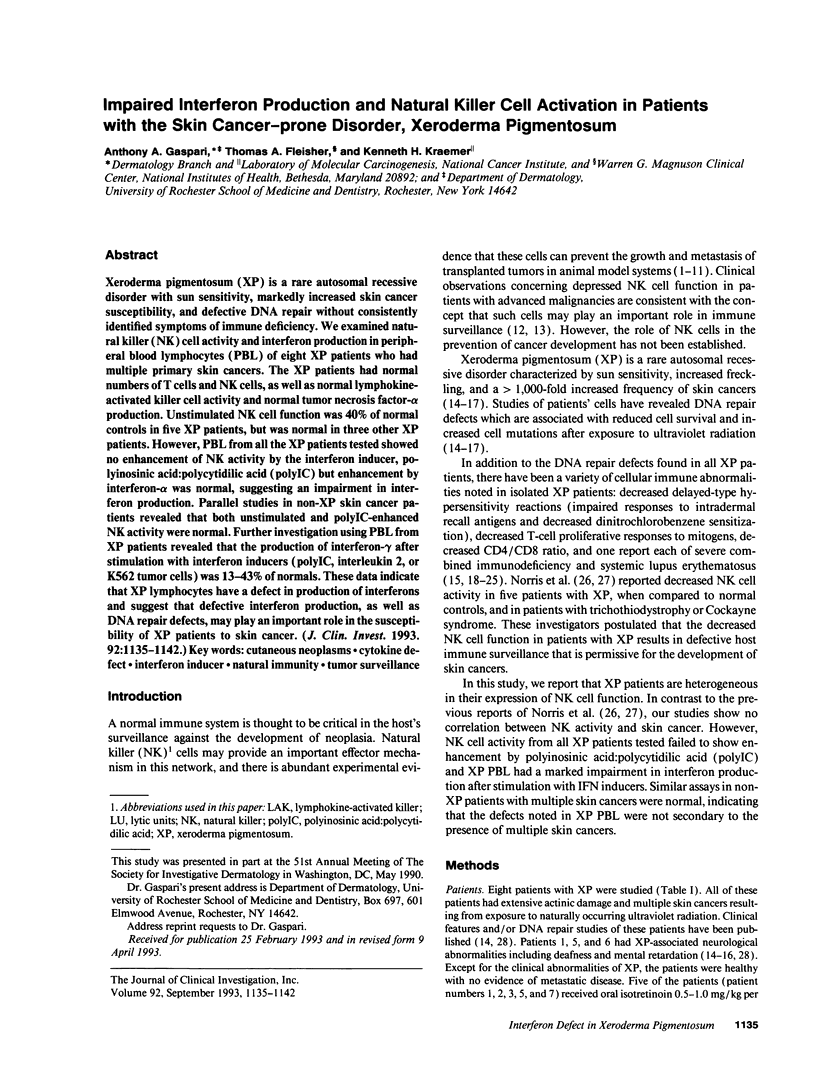
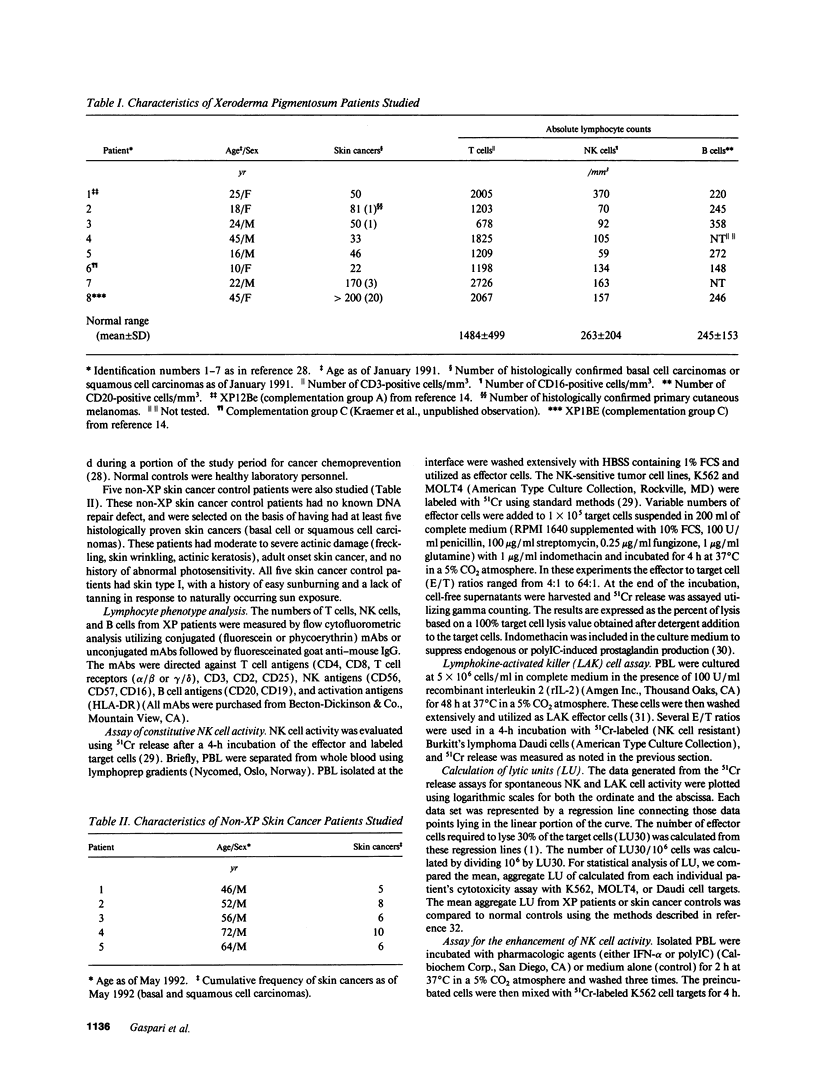
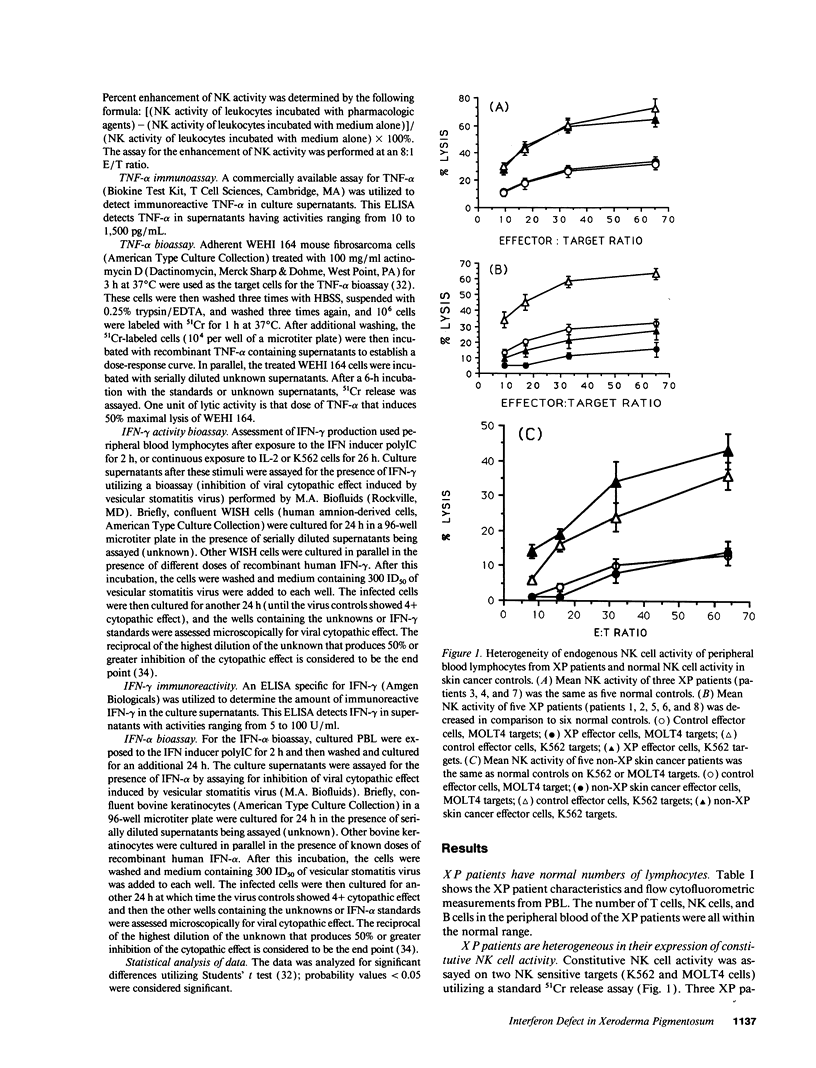
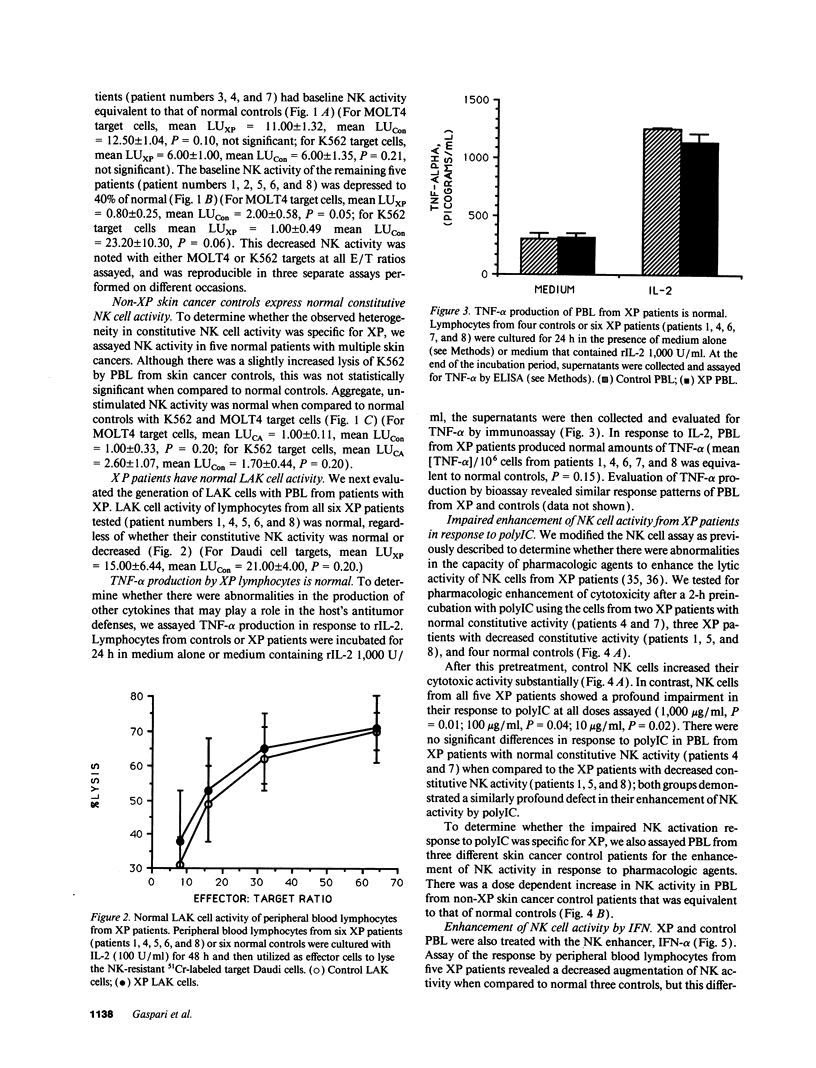
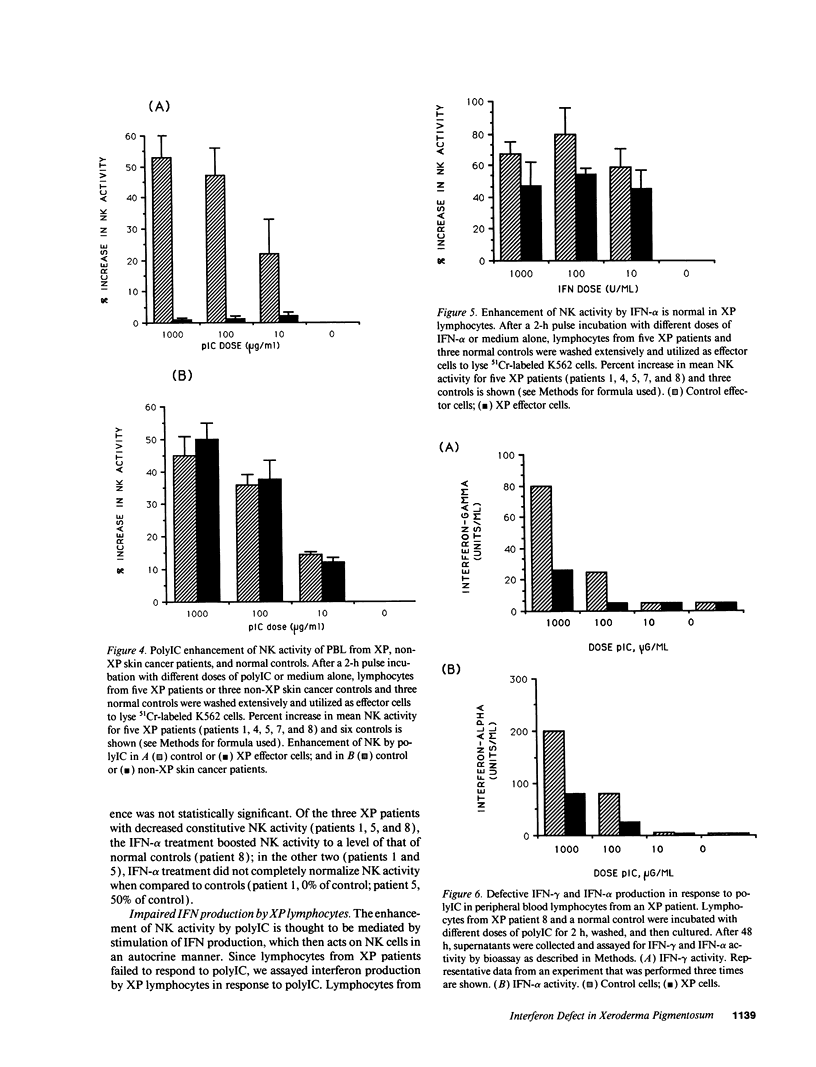
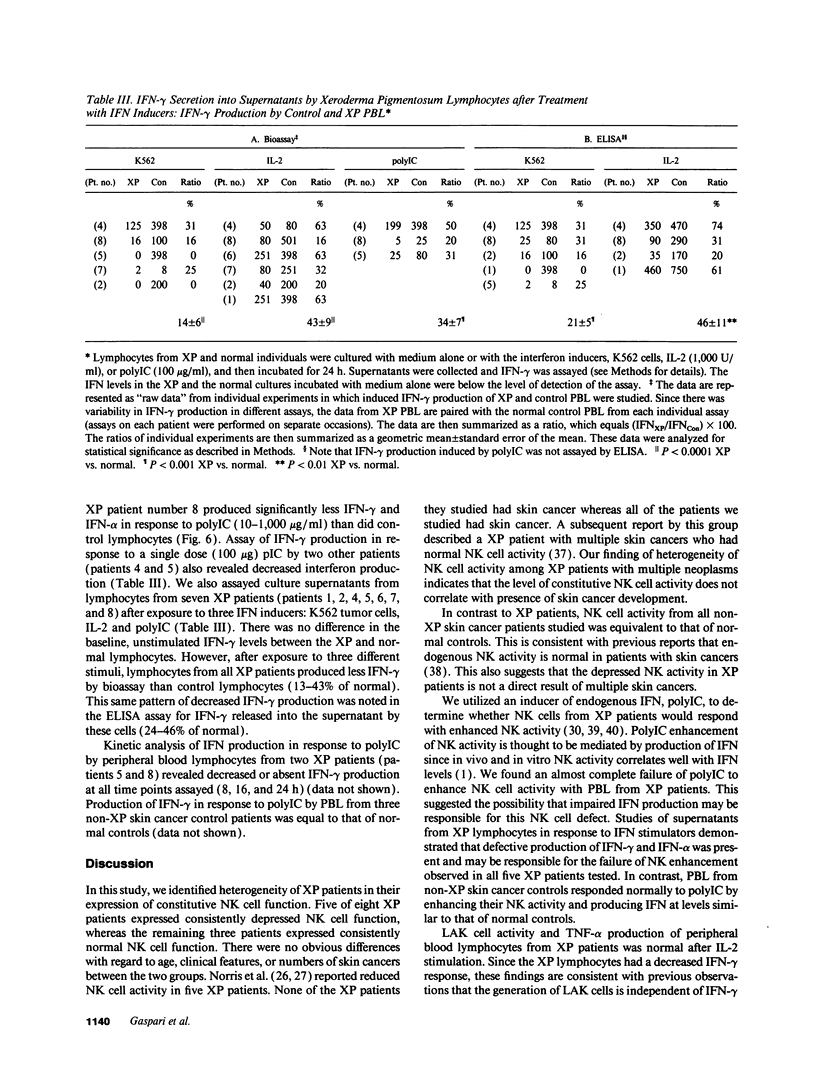
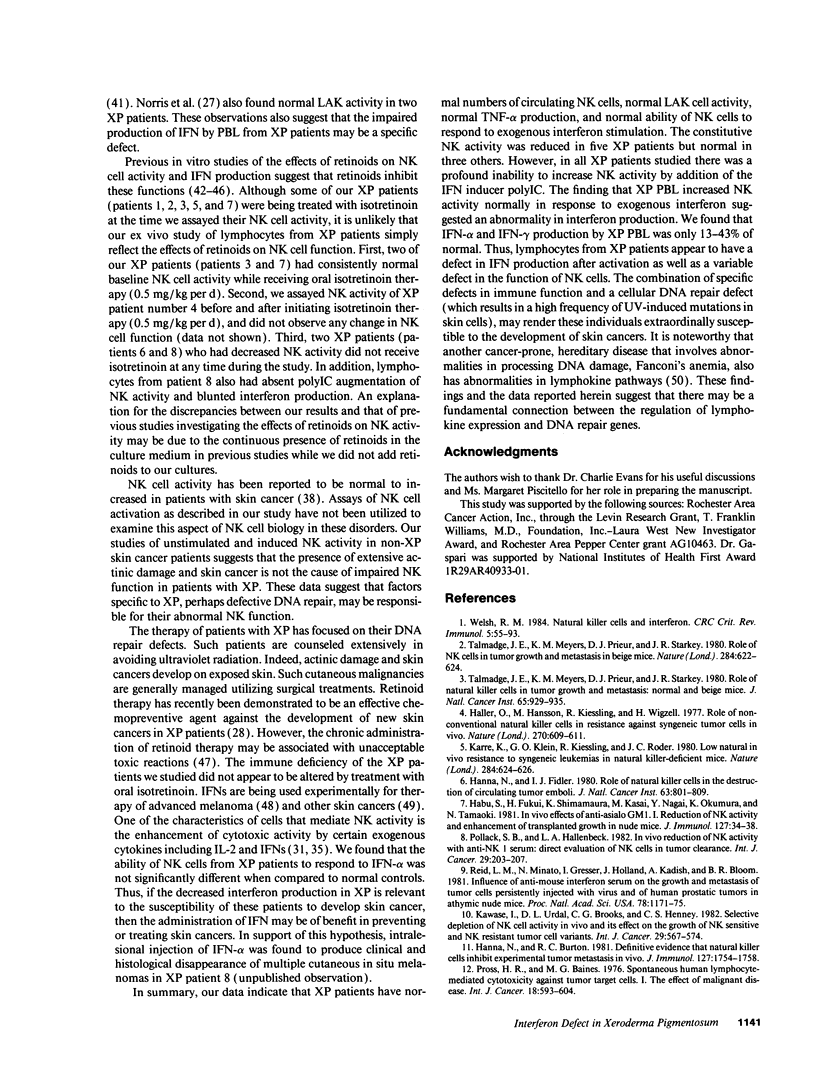
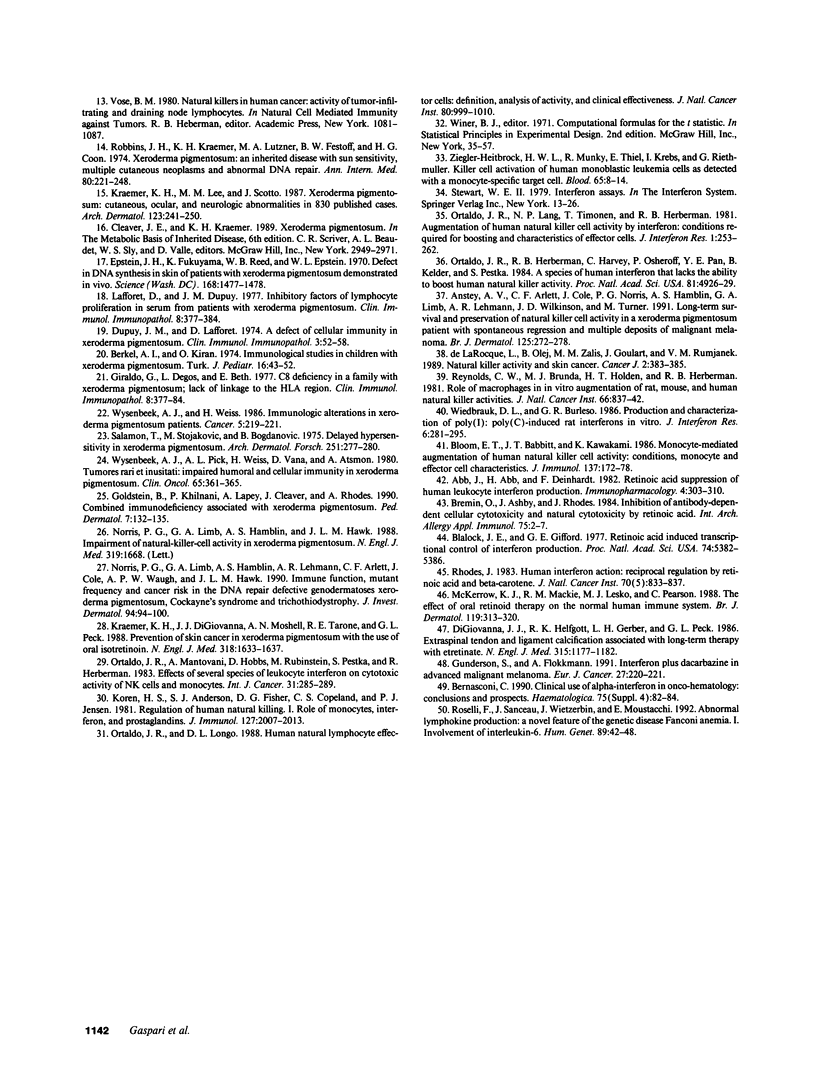
Selected References
These references are in PubMed. This may not be the complete list of references from this article.
- Abb J., Abb H., Deinhardt F. Retinoic acid suppression of human leukocyte interferon production. Immunopharmacology. 1982 Aug;4(4):303–310. doi: 10.1016/0162-3109(82)90051-0. [DOI] [PubMed] [Google Scholar]
- Anstey A. V., Arlett C. F., Cole J., Norris P. G., Hamblin A. S., Limb G. A., Lehmann A. R., Wilkinson J. D., Turner M. Long-term survival and preservation of natural killer cell activity in a xeroderma pigmentosum patient with spontaneous regression and multiple deposits of malignant melanoma. Br J Dermatol. 1991 Sep;125(3):272–278. doi: 10.1111/j.1365-2133.1991.tb14754.x. [DOI] [PubMed] [Google Scholar]
- Berkel A. I., Kiran O. Immunological studies in children with xeroderma pigmentosum. Turk J Pediatr. 1974 Apr;16(2):43–52. [PubMed] [Google Scholar]
- Bernasconi C. Impiego clinico dell'alfa interferon in oncoematologia: conclusioni e prospettive. Haematologica. 1990 Jul-Aug;75 (Suppl 4):82–84. [PubMed] [Google Scholar]
- Blalock J. E., Gifford G. E. Retinoic acid (vitamin A acid) induced transcriptional control of interferon production. Proc Natl Acad Sci U S A. 1977 Dec;74(12):5382–5386. doi: 10.1073/pnas.74.12.5382. [DOI] [PMC free article] [PubMed] [Google Scholar]
- Bloom E. T., Babbitt J. T., Kawakami K. Monocyte-mediated augmentation of human natural killer cell activity: conditions, monocyte and effector cell characteristics. J Immunol. 1986 Jul 1;137(1):172–178. [PubMed] [Google Scholar]
- DiGiovanna J. J., Helfgott R. K., Gerber L. H., Peck G. L. Extraspinal tendon and ligament calcification associated with long-term therapy with etretinate. N Engl J Med. 1986 Nov 6;315(19):1177–1182. doi: 10.1056/NEJM198611063151901. [DOI] [PubMed] [Google Scholar]
- Dupuy J. M., Lafforet D. A defect of cellular immunity in Xeroderma pigmentosum. Clin Immunol Immunopathol. 1974 Sep;3(1):52–58. doi: 10.1016/0090-1229(74)90022-1. [DOI] [PubMed] [Google Scholar]
- Epstein J. H., Fukuyama K., Reed W. B., Epstein W. L. Defect in DNA synthesis in skin of patients with xeroderma pigmentosum demonstrated in vivo. Science. 1970 Jun 19;168(3938):1477–1478. doi: 10.1126/science.168.3938.1477. [DOI] [PubMed] [Google Scholar]
- Eremin O., Ashby J., Rhodes J. Inhibition of antibody-dependent cellular cytotoxicity and natural cytotoxicity by retinoic acid. Int Arch Allergy Appl Immunol. 1984;75(1):2–7. doi: 10.1159/000233581. [DOI] [PubMed] [Google Scholar]
- Giraldo G., Degos L., Beth E., Sasportes M., Marcelli A., Gharbi R., Day N. K. C8 deficiency in a family with xeroderma pigmentosum. Lack of linkage to the HLA region. Clin Immunol Immunopathol. 1977 Nov;8(3):377–384. doi: 10.1016/0090-1229(77)90002-2. [DOI] [PubMed] [Google Scholar]
- Giraldo G., Degos L., Beth E., Sasportes M., Marcelli A., Gharbi R., Day N. K. C8 deficiency in a family with xeroderma pigmentosum. Lack of linkage to the HLA region. Clin Immunol Immunopathol. 1977 Nov;8(3):377–384. doi: 10.1016/0090-1229(77)90002-2. [DOI] [PubMed] [Google Scholar]
- Goldstein B., Khilnani P., Lapey A., Cleaver J. E., Rhodes A. R. Combined immunodeficiency associated with xeroderma pigmentosum. Pediatr Dermatol. 1990 Jun;7(2):132–135. doi: 10.1111/j.1525-1470.1990.tb00669.x. [DOI] [PubMed] [Google Scholar]
- Gundersen S., Flokkmann A. Interferon plus dacarbazine in advanced malignant melanoma: a phase I-II study. Eur J Cancer. 1991;27(2):220–221. doi: 10.1016/0277-5379(91)90497-2. [DOI] [PubMed] [Google Scholar]
- Habu S., Fukui H., Shimamura K., Kasai M., Nagai Y., Okumura K., Tamaoki N. In vivo effects of anti-asialo GM1. I. Reduction of NK activity and enhancement of transplanted tumor growth in nude mice. J Immunol. 1981 Jul;127(1):34–38. [PubMed] [Google Scholar]
- Haller O., Hansson M., Kiessling R., Wigzell H. Role of non-conventional natural killer cells in resistance against syngeneic tumour cells in vivo. Nature. 1977 Dec 15;270(5638):609–611. doi: 10.1038/270609a0. [DOI] [PubMed] [Google Scholar]
- Hanna N., Burton R. C. Definitive evidence that natural killer (NK) cells inhibit experimental tumor metastases in vivo. J Immunol. 1981 Nov;127(5):1754–1758. [PubMed] [Google Scholar]
- Hanna N., Fidler I. J. Role of natural killer cells in the destruction of circulating tumor emboli. J Natl Cancer Inst. 1980 Oct;65(4):801–809. doi: 10.1093/jnci/65.4.801. [DOI] [PubMed] [Google Scholar]
- Kawase I., Urdal D. L., Brooks C. G., Henney C. S. Selective depletion of NK cell activity in vivo and its effect on the growth of NK-sensitive and NK-resistant tumor cell variants. Int J Cancer. 1982 May 15;29(5):567–574. doi: 10.1002/ijc.2910290513. [DOI] [PubMed] [Google Scholar]
- Koren H. S., Anderson S. J., Fischer D. G., Copeland C. S., Jensen P. J. Regulation of human natural killing. I. The role of monocytes, interferon, and prostaglandins. J Immunol. 1981 Nov;127(5):2007–2013. [PubMed] [Google Scholar]
- Kraemer K. H., DiGiovanna J. J., Moshell A. N., Tarone R. E., Peck G. L. Prevention of skin cancer in xeroderma pigmentosum with the use of oral isotretinoin. N Engl J Med. 1988 Jun 23;318(25):1633–1637. doi: 10.1056/NEJM198806233182501. [DOI] [PubMed] [Google Scholar]
- Kraemer K. H., Lee M. M., Scotto J. Xeroderma pigmentosum. Cutaneous, ocular, and neurologic abnormalities in 830 published cases. Arch Dermatol. 1987 Feb;123(2):241–250. doi: 10.1001/archderm.123.2.241. [DOI] [PubMed] [Google Scholar]
- Kärre K., Klein G. O., Kiessling R., Klein G., Roder J. C. Low natural in vivo resistance to syngeneic leukaemias in natural killer-deficient mice. Nature. 1980 Apr 17;284(5757):624–626. doi: 10.1038/284624a0. [DOI] [PubMed] [Google Scholar]
- McKerrow K. J., MacKie R. M., Lesko M. J., Pearson C. The effect of oral retinoid therapy on the normal human immune system. Br J Dermatol. 1988 Sep;119(3):313–320. doi: 10.1111/j.1365-2133.1988.tb03223.x. [DOI] [PubMed] [Google Scholar]
- Norris P. G., Limb G. A., Hamblin A. S., Hawk J. L. Impairment of natural-killer-cell activity in xeroderma pigmentosum. N Engl J Med. 1988 Dec 22;319(25):1668–1669. doi: 10.1056/NEJM198812223192512. [DOI] [PubMed] [Google Scholar]
- Norris P. G., Limb G. A., Hamblin A. S., Lehmann A. R., Arlett C. F., Cole J., Waugh A. P., Hawk J. L. Immune function, mutant frequency, and cancer risk in the DNA repair defective genodermatoses xeroderma pigmentosum, Cockayne's syndrome, and trichothiodystrophy. J Invest Dermatol. 1990 Jan;94(1):94–100. doi: 10.1111/1523-1747.ep12873952. [DOI] [PubMed] [Google Scholar]
- Ortaldo J. R., Herberman R. B., Harvey C., Osheroff P., Pan Y. C., Kelder B., Pestka S. A species of human alpha interferon that lacks the ability to boost human natural killer activity. Proc Natl Acad Sci U S A. 1984 Aug;81(15):4926–4929. doi: 10.1073/pnas.81.15.4926. [DOI] [PMC free article] [PubMed] [Google Scholar]
- Ortaldo J. R., Lang N. P., Timonen T., Herberman R. B. Augmentation of human natural killer cell activity by interferon: conditions required for boosting and characteristics of the effector cells. J Interferon Res. 1981 Feb;1(2):253–262. doi: 10.1089/jir.1981.1.253. [DOI] [PubMed] [Google Scholar]
- Ortaldo J. R., Longo D. L. Human natural lymphocyte effector cells: definition, analysis of activity, and clinical effectiveness. J Natl Cancer Inst. 1988 Sep 7;80(13):999–1010. doi: 10.1093/jnci/80.13.999. [DOI] [PubMed] [Google Scholar]
- Ortaldo J. R., Mantovani A., Hobbs D., Rubinstein M., Pestka S., Herberman R. B. Effects of several species of human leukocyte interferon on cytotoxic activity of NK cells and monocytes. Int J Cancer. 1983 Mar 15;31(3):285–289. doi: 10.1002/ijc.2910310306. [DOI] [PubMed] [Google Scholar]
- Pollack S. B., Hallenbeck L. A. In vivo reduction of NK activity with anti-NK 1 serum: direct evaluation of NK cells in tumor clearance. Int J Cancer. 1982 Feb 15;29(2):203–207. doi: 10.1002/ijc.2910290215. [DOI] [PubMed] [Google Scholar]
- Pross H. F., Baines M. G. Spontaneous human lymphocyte-mediated cytotoxicity againts tumour target cells. I. The effect of malignant disease. Int J Cancer. 1976 Nov 15;18(5):593–604. doi: 10.1002/ijc.2910180508. [DOI] [PubMed] [Google Scholar]
- Reid L. M., Minato N., Gresser I., Holland J., Kadish A., Bloom B. R. Influence of anti-mouse interferon serum on the growth and metastasis of tumor cells persistently infected with virus and of human prostatic tumors in athymic nude mice. Proc Natl Acad Sci U S A. 1981 Feb;78(2):1171–1175. doi: 10.1073/pnas.78.2.1171. [DOI] [PMC free article] [PubMed] [Google Scholar]
- Reynolds C. W., Brunda M. J., Holden H. T., Herberman R. B. Role of macrophage in in vitro augmentation of rat, mouse, and human natural killer activities. J Natl Cancer Inst. 1981 May;66(5):837–842. [PubMed] [Google Scholar]
- Rhodes J. Human interferon action: reciprocal regulation by retinoic acid and beta-carotene. J Natl Cancer Inst. 1983 May;70(5):833–837. [PubMed] [Google Scholar]
- Robbins J. H., Kraemer K. H., Lutzner M. A., Festoff B. W., Coon H. G. Xeroderma pigmentosum. An inherited diseases with sun sensitivity, multiple cutaneous neoplasms, and abnormal DNA repair. Ann Intern Med. 1974 Feb;80(2):221–248. doi: 10.7326/0003-4819-80-2-221. [DOI] [PubMed] [Google Scholar]
- Rosselli F., Sanceau J., Wietzerbin J., Moustacchi E. Abnormal lymphokine production: a novel feature of the genetic disease Fanconi anemia. I. Involvement of interleukin-6. Hum Genet. 1992 Apr;89(1):42–48. doi: 10.1007/BF00207040. [DOI] [PubMed] [Google Scholar]
- Salamon T., Stojaković M., Bogdanović B. Delayed hypersensitivity in xeroderma pigmentosum. Arch Dermatol Forsch. 1975;251(4):277–280. doi: 10.1007/BF00562230. [DOI] [PubMed] [Google Scholar]
- Talmadge J. E., Meyers K. M., Prieur D. J., Starkey J. R. Role of NK cells in tumour growth and metastasis in beige mice. Nature. 1980 Apr 17;284(5757):622–624. doi: 10.1038/284622a0. [DOI] [PubMed] [Google Scholar]
- Talmadge J. E., Meyers K. M., Prieur D. J., Starkey J. R. Role of natural killer cells in tumor growth and metastasis: C57BL/6 normal and beige mice. J Natl Cancer Inst. 1980 Nov;65(5):929–935. [PubMed] [Google Scholar]
- Welsh R. M. Natural killer cells and interferon. Crit Rev Immunol. 1984;5(1):55–93. [PubMed] [Google Scholar]
- Wiedbrauk D. L., Burleson G. R. Production and characterization of poly(I):poly(C)-induced rat interferons in vitro. J Interferon Res. 1986 Jun;6(3):281–295. doi: 10.1089/jir.1986.6.281. [DOI] [PubMed] [Google Scholar]
- Wysenbeek A. J., Pick A. I., Weiss H., Vana D., Atsmon A. Impaired humoral and cellular immunity in xeroderma pigmentosum. Clin Oncol. 1980 Dec;6(4):361–365. [PubMed] [Google Scholar]
- Wysenbeek A. J., Weiss H., Duczyminer-Kahana M., Grunwald M. H., Pick A. I. Immunologic alterations in xeroderma pigmentosum patients. Cancer. 1986 Jul 15;58(2):219–221. doi: 10.1002/1097-0142(19860715)58:2<219::aid-cncr2820580203>3.0.co;2-a. [DOI] [PubMed] [Google Scholar]
- Ziegler-Heitbrock H. W., Munker R., Thiel E., Krebs I., Riethmüller G. Killer cell activity of human monoblastic leukemia cells as detected with a monocyte-specific target cell. Blood. 1985 Jan;65(1):8–14. [PubMed] [Google Scholar]


